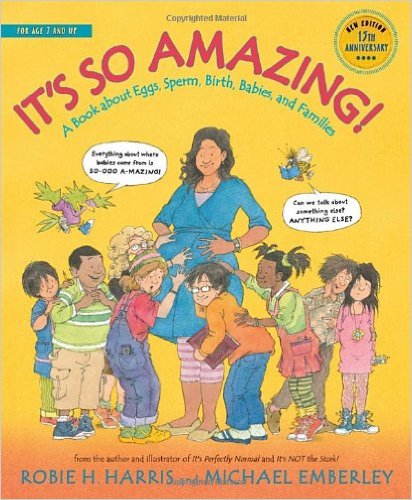Pregnancy and Reproduction Explained
This video breaks down the process of reproduction by explaining that if a fertilized egg attaches to the wall of a uterus, pregnancy has begun. It explains that typically sperm combines with an egg through vaginal sex, and semen is ejaculated and carries the sperm through the cervix and the uterus and into the fallopian tubes, where it meets the egg and implants on the uteran wall. The video also defines artificial insemination and in vitro fertilization. It also clarifies that pregnancy and childbirth are just one way a family can be formed – some people choose to adopt or not to have kids. [AMZ-045]
Youth
Once you start to go through puberty, it’s possible to get pregnant or get someone pregnant, which is why it’s important to be familiar with different ways to prevent pregnancy. When people use birth control, or contraception, they use a medicine, medical device or barrier like a condom to keep a sperm and an egg from uniting. Some birth control, like the Pill, the Patch and the Shot, are medicines that keep the ovary from releasing an egg or ovum. Other birth control methods help create a barrier at the opening of the cervix to keep sperm from getting inside the uterus to find an egg. Abstinence, or choosing to not have or delay having sex, is the most effective form of birth control.
FAQs
There are a lot of myths out there about if, how and when someone can or can’t get pregnant. The truth is, once you start to go through puberty, it’s possible to get pregnant or get someone pregnant. That’s why it’s so important to know how pregnancy happens and how to prevent it if you or your partner are not ready.
Additional Resources
Parents
Birth control, or contraception, is a medicine, a medical device or a barrier like a condom to keep a sperm and an egg from uniting. Some birth control methods, like hormonal methods, work to keep the ovary from releasing an egg or ovum, while others help create a barrier at the opening of the cervix to keep sperm from getting inside the uterus to find an egg. Abstinence, or choosing to not have or delay having sex, is the most effective form of birth control. If someone chooses to have penile-vaginal sex, then using a condom and another form of birth control at the same time is the most effective protection possible because contraceptive methods other than internal or external condoms do not reduce the risk of sexually transmitted diseases (STDs).
The Pill, Patch, Ring and Shot
Birth control pills must be taken every day at about the same time. A package of birth control pills will last a month. They are very effective at preventing unintended pregnancy if they are taken as directed. Some methods of birth control, like the Patch and Ring, can prevent pregnancy for many weeks. A person needs to go to their health care provider or a family planning clinic to get a prescription for these methods of birth control. Many teens and young adults who have penile-vaginal sex and use the Pill, Patch or Ring also use a condom to provide an additional layer of protection against pregnancy and reduce the risk of STDs.
Depo-Provera, also known as the Shot, is a contraceptive that is injected into a person every 12 weeks and provides protection against pregnancy during that time by preventing ovulation. Like other hormonal methods of birth control, the Shot releases a hormone into the body to keep the ovary from releasing an egg. The Shot also makes cervical mucus thicker, helping to keep sperm from getting to the egg.
Long-Acting Reversible Contraception (LARC)
Using a long-acting reversible contraception, sometimes called a LARC, along with a condom is the most effective protection against unintended pregnancy and STDs. LARCs include birth control methods like the contraceptive shot, the contraceptive implant and intrauterine devices (IUDs). Each is more than 99-percent effective at preventing an unplanned pregnancy and lasts a long time.
The contraceptive implant, sometimes called Nexplanon, is about the size and shape of a matchstick. The implant releases hormones into the body to prevent pregnancy. The hormone keeps the ovaries from releasing an egg and also thickens the cervical mucus to stop sperm from getting into the uterus to find an egg. A nurse or doctor inserts the implant into your upper arm. It can provide up to three years of protection against pregnancy.
The IUD is a small piece of flexible plastic shaped like a T. A health care provider inserts the IUD into the uterus. Some IUDs have copper wire, while others release hormones into the body. Both make it difficult for sperm to get to an egg. IUDs can last for years depending on which one a person has inserted. Some last for up to five years and some for up to 12! When a person is ready to have a baby, a health care provider can simply take the IUD out, and a person is able to get pregnant after that.
While all of these hormonal methods are highly effective at preventing pregnancy, none provide protection against STDs. So it’s important to also use a latex condom when you have sex.
CONVERSATION STARTERS
Parents or guardians can start talking with their children about pregnancy and how to prevent it before their children become sexually active. When parents and guardians talk with their children about these topics, children learn that they can come to their parents if and when they have questions. Below are some ways to start these conversations:
“Do you think those two characters are ready to have a baby?” You could also ask, “How do you think they could have prevented the pregnancy?”
Educators
Birth control, or contraception, is a medicine, a medical device or a barrier like a condom to keep a sperm and an egg from uniting. Some birth control methods, like hormonal methods, work to keep the ovary from releasing an egg or ovum, while others help create a barrier at the opening of the cervix to keep sperm from getting inside the uterus to find an egg. Abstinence, or choosing to not have or delay having sex, is the most effective form of birth control. If someone chooses to have penile-vaginal sex, then using a condom and another form of birth control at the same time is the most effective protection possible because contraceptive methods other than internal or external condoms do not reduce the risk of sexually transmitted diseases (STDs).
The Pill, Patch, Ring and Shot
Birth control pills must be taken every day at about the same time. A package of birth control pills will last a month. They are very effective at preventing unintended pregnancy if they are taken as directed. Some methods of birth control, like the Patch and Ring, can prevent pregnancy for many weeks. A person needs to go to their health care provider or a family planning clinic to get a prescription for these methods of birth control. Many teens and young adults who have penile-vaginal sex and use the Pill, Patch or Ring also use a condom to provide an additional layer of protection against pregnancy and reduce the risk of STDs.
Depo-Provera, also known as the Shot, is a contraceptive that is injected into a person every 12 weeks and provides protection against pregnancy during that time by preventing ovulation. Like other hormonal methods of birth control, the Shot releases a hormone into the body to keep the ovary from releasing an egg. The Shot also makes cervical mucus thicker, helping to keep sperm from getting to the egg.
Long-Acting Reversible Contraception (LARC)
Using a long-acting reversible contraception, sometimes called a LARC, along with a condom is the most effective protection possible against unintended pregnancy and STDs. LARCs include birth control methods like the contraceptive shot, the contraceptive implant and intrauterine devices (IUDs). Each is more than 99-percent effective at preventing an unplanned pregnancy and lasts a long time.
The contraceptive implant, sometimes called Nexplanon, is about the size and shape of a matchstick. The implant releases hormones into the body to prevent pregnancy. The hormone keeps the ovaries from releasing an egg and also thickens the cervical mucus to stop sperm from getting into the uterus to find an egg. A nurse or doctor inserts the implant into your upper arm. It can provide up to three years of protection against pregnancy.
The IUD is a small piece of flexible plastic shaped like a T. A health care provider inserts the IUD into the uterus. Some IUDs have copper wire, while others release hormones into the body. Both make it difficult for sperm to get to an egg. IUDs can last for years depending on which one you get. Some last for up to five years and some for up to 12! When a person is ready to have a baby, a health care provider can simply take the IUD out, and a person is able to get pregnant after that.
While all of these hormonal methods are highly effective at preventing pregnancy, none provide protection against STDs. So it’s important to also use a latex condom when you have sex.
National Sex Education Standards
Explain the relationship between sexual intercourse and human reproduction
Explain the range of ways pregnancy can occur (e.g., IVF, surrogacy)
Define reproduction and explain that all living things may have the capacity to reproduce
Recall the human reproductive systems, including the external and internal body parts and their functions, and that there are natural variations in human bodies
International Technical Guidance on Sexuality Education
Discussion Questions
- What are some methods of birth control or contraception that you learned about in this video?
- What methods prevent pregnancy and reduce the risk of sexually transmitted diseases?
- What is the most effective way for someone to prevent pregnancy if they are not ready or don’t want to have a baby?
- Where could you get more information if you still have questions about pregnancy and reproduction?




